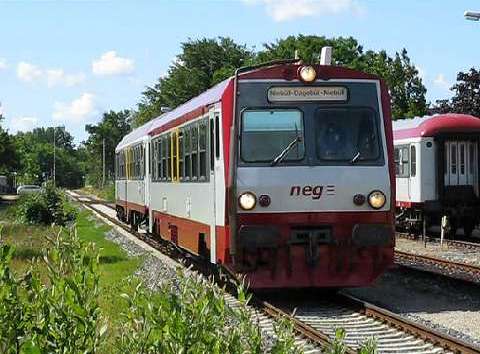|
Comments welcome : charlie@davenportstation.org.uk |
The Altfelden pages are devoted to my unhealthy obsession with all things relating to Austrian railway branch lines of the 1990s - even unto the present day - and my little model railway 'Altfelden' which tries to recreate the happy days I have spent visiting and travelling on these lines. I hope they will be of interest, especially to my friends in the Austrian Railway Group. - Charlie Hulme,
The Jenbach Integral
A few words about another Jenbach export order
The Bayerische Oberland Bahn (BOB) which took over operation of the Tegernseebahn and nearby DB lines in Bavaria, were persuaded to order from Jenbach seventeen units of a new low-floor articulated type dubbed the 'Integral' which appeared in 1998. These were something of a disaster, having to have all kinds of rectification work (reportedly costing Jenbacher Werke 22 million Euros) before they became reliable, and sadly became the last railway vehicles to emerge from the Jenbach works which returned to its core business of making stationary diesel and gas engines and generating plant, and is now owned by General Electric of the USA.
Links:
Some pictures of T 4 and other stock in original NVAG colours - by Rolf Köstner
Nahne Johannsen's website: includes 'Wittenberger-Kopf' and 'neg' galleries
The NEG-Niebüll company website (Webcam)
Neg fleet list (at privat-bahn.de)
An Austrian in Nordfriesland:NEG Railcar T4

(Inspired by an article in Eisenbahn Illustrierte, May 1995)
In January 1995, Jenbacher Transportsysteme AG (JTS), the German arm of Jenbacher Werke of Austria (builders of the Austrian class 2043 and 2068 locomotives) received an order for a modern diesel railcar. After visiting the test runs by an OBB 5047 on routes in the Thuringer Wald, operated by Thuringer Rennsteigbahn AG, Nordfriesische Verkehrsbetriebe AG (NVAG) from Schleswig-Holstein ordered one.
The route operated by NVAG is about 14 km long and connects the Intercity station of Niebüll with the Dagebüll Mole, the starting point for the ferries to the on the North Sea islands Föhr and Amrum. This line gets very busy on the summer, with sometimes as many as 400 people waiting for trains.
In 2004, NVAG began a new push-pull train operation, using three ByL center-entrance coaches of the "Wittenberg" type powered by ex-DB V100 loco 211 233. This machine, numbered DL 2 Nordfriesland is no longer recognisable as a V 100, having been rebuilt by ABB Henschel with a new body and engine. Only the frame, bogies and transmission of the V 100 were retained.
The NVAG railcar is based on the hundred units already in service in Austria, and considered the "saviour of the branch lines." Although the Dagebüll line runs over almost flat terrain, with an 80 km/h maximum speed, the Jenbach railcar could expect harsh operating conditions: it is required to haul through coaches from the main line, and work push-pull with driving trailers. Thus, the transmission of this vehicle was re-geared for a maximum speed of 100 km/h rather than the 120 km/h of the 5047 units, to achieve a greater starting tractive effort. It is also equipped to supply electrical power for heating up to five coaches by means of a 40 kW diesel-powered generator. Otherwise, it is technically identical to the 5047. The main engine is an MTU 12V183TC12 of 423 kW (575 hp) (originally Daimler Benz type OM 444 LA)
The interior layout differs from the 5047. It consists of non-smoking seond class open accommodation plus a separate first class compartment (indicated by yellow around the windows). Seating capacity is 71 (7 first, 64 second) compared to 62 seats in 5047.Original livery was Ruby Red and Perlweiß (RAL 1013) with Silver Grey (RAL 7001) roof.
The "Austrian", works number J3894.103. fleet number T4, joined the existing railcar fleet of NVAG, T2 built by Esslingen 1954 and T3 built by MaK in 1961. With this order, Jenbach were hoping to enter the German market, in competition with the similar type "NE 81" single cars on offer from Waggon Union Berlin, when more branch lines were handed over to local operators from 1 January 1996. But further German orders for the type never materialised, and the design was made obsolete by the requirement for low-floor vehicles.

It runs when required with a driving trailer, vehicle no. 101, seen above, with a cab of the so-called 'Witterberger-kopf' design, rebuilt in 1991 at Wittenberge works from an ex-DB carriage of type Byl(b) 422, no. 50 80 21-11 622-5. This can also be used with the company's two ex-DB Byl coaches, 102 and 103, and loco DL 2.
The NVAG company became insolvent in 2004 and its operations passed to Norddeutsche Eisenbahngesellschaft Niebüll GmbH" (neg) a subsidiary of the Luxembourg State Railway (CFL), which continues to operate T4, using a livery based on that of the CFL. The older railcars are no longer in use, and the loco DL2 has been renumbered 211.002. Our pictures were taken at Niebüll in July 2008.
Last update January 2014